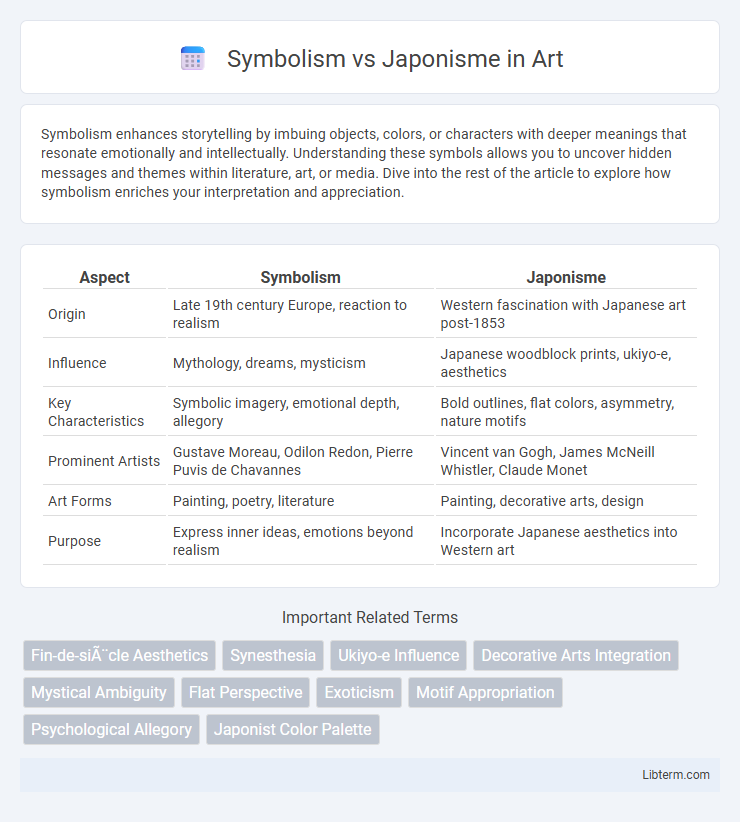Symbolism enhances storytelling by imbuing objects, colors, or characters with deeper meanings that resonate emotionally and intellectually. Understanding these symbols allows you to uncover hidden messages and themes within literature, art, or media. Dive into the rest of the article to explore how symbolism enriches your interpretation and appreciation.
Table of Comparison
| Aspect | Symbolism | Japonisme |
|---|---|---|
| Origin | Late 19th century Europe, reaction to realism | Western fascination with Japanese art post-1853 |
| Influence | Mythology, dreams, mysticism | Japanese woodblock prints, ukiyo-e, aesthetics |
| Key Characteristics | Symbolic imagery, emotional depth, allegory | Bold outlines, flat colors, asymmetry, nature motifs |
| Prominent Artists | Gustave Moreau, Odilon Redon, Pierre Puvis de Chavannes | Vincent van Gogh, James McNeill Whistler, Claude Monet |
| Art Forms | Painting, poetry, literature | Painting, decorative arts, design |
| Purpose | Express inner ideas, emotions beyond realism | Incorporate Japanese aesthetics into Western art |
Introduction to Symbolism and Japonisme
Symbolism emerged in the late 19th century as an artistic movement emphasizing metaphoric and often mystical representations to convey deeper truths beyond naturalistic depiction. Japonisme, a parallel influence, introduced Western art to Japanese aesthetics, characterized by flat planes, bold lines, and asymmetrical compositions, profoundly impacting Impressionist and Post-Impressionist artists. The fusion of Symbolist themes with Japonisme aesthetics created a unique cross-cultural artistic dialogue that reshaped visual expression during the Belle Epoque period.
Historical Contexts of Symbolism and Japonisme
Symbolism emerged in the late 19th century as a reaction against realism and naturalism, emphasizing mystical and subjective interpretations of reality, deeply influenced by Romanticism and the Decadent movement. Japonisme arose in the same period, sparked by increased trade and cultural exchange between Europe and Japan after Japan opened to the West in the 1850s, leading to widespread fascination with Japanese art, design, and aesthetics among European artists. Both movements shaped modern art by challenging traditional Western perspectives: Symbolism through its exploration of the subconscious and spirituality, and Japonisme through the integration of Japanese motifs, flat perspectives, and nature-inspired themes.
Defining Features of Symbolism
Symbolism, emerging in the late 19th century, is defined by its emphasis on representing ideas and emotions through metaphorical imagery and abstract forms rather than direct realism. It prioritizes subjective experience, mysticism, and the exploration of the inner psyche, often using mythological and dreamlike symbolism to evoke deeper meanings. Unlike Japonisme, which draws inspiration from Japanese art and aesthetics, Symbolism is rooted in Western literary and philosophical traditions, focusing on internal symbolism rather than external cultural motifs.
Core Elements of Japonisme in Art
Japonisme in art centers on the integration of traditional Japanese aesthetics, including flat planes of color, asymmetrical compositions, and an emphasis on nature motifs like cherry blossoms and cranes. Core elements also feature the use of ukiyo-e woodblock prints, which influenced Western artists to adopt simplified forms and bold outlines. These characteristics contrast with Symbolism's focus on mystical themes and internal meanings, highlighting Japonisme's impact on decorative style and visual harmony.
Major Artists Influencing Symbolism
Major artists influencing Symbolism include Gustave Moreau, Odilon Redon, and Arnold Bocklin, who emphasized mysticism, dreams, and inner visions. Their work often featured allegorical and mythological themes, contrasting with Japonisme's focus on Japanese aesthetics, flat compositions, and natural motifs. Symbolism's influence extended deeply into literature and visual arts, shaping emotional expression beyond Japonisme's decorative and stylistic appeal.
Japonisme’s Influence on Western Art
Japonisme significantly shaped Western art in the late 19th century by introducing Japanese aesthetics such as asymmetry, flat color fields, and natural motifs, which contrasted with traditional European techniques. Western artists like Claude Monet and Vincent van Gogh incorporated these elements into their work, leading to a stylistic shift that emphasized simplicity and bold composition. This cultural exchange broadened artistic perspectives and contributed to the development of modern art movements such as Impressionism and Art Nouveau.
Visual Motifs: Comparing Symbolist and Japonisme Styles
Symbolism employs evocative, dream-like visuals emphasizing mythological and mystical motifs such as spirals, serpents, and allegorical figures to represent inner emotions and abstract concepts. Japonisme draws heavily on Japanese woodblock prints, featuring flat planes of color, asymmetrical compositions, and natural elements like cherry blossoms, cranes, and waves to capture simplicity and elegance. Both styles prioritize symbolic meaning in their visual motifs but differ in execution--Symbolism leans toward intricate, layered symbolism, while Japonisme focuses on minimalistic, decorative patterns inspired by Japanese aesthetics.
Cross-Cultural Exchanges and Inspirations
Symbolism and Japonisme both thrive on cross-cultural exchanges, with Symbolist artists drawing inspiration from the mysticism and evocative imagery prevalent in Japanese art. Japonisme introduced Symbolists to new aesthetics such as flat perspectives, bold lines, and nature motifs, which enriched their exploration of dreams and the subconscious. This fusion of Western symbolism and Eastern artistic principles fostered innovative visual languages that redefined late 19th-century art.
Enduring Legacy of Symbolism and Japonisme
Symbolism's enduring legacy lies in its profound influence on modern art, literature, and psychology, emphasizing themes of spirituality, dreams, and the subconscious. Japonisme's impact reshaped Western aesthetics by introducing Japanese motifs, asymmetrical compositions, and refined simplicity, revolutionizing painting, design, and decorative arts in the late 19th and early 20th centuries. Together, these movements fostered a cross-cultural dialogue that enriched artistic expression and inspired avant-garde innovations worldwide.
Conclusion: Artistic Dialogue Between Symbolism and Japonisme
Symbolism and Japonisme engaged in a profound artistic dialogue that reshaped Western art by merging mystical themes with Japanese aesthetics. Symbolism's emphasis on dreams, emotions, and mythology found visual harmony in Japonisme's intricate patterns, asymmetry, and delicate composition. This cross-cultural exchange enriched artists' vocabularies, fostering innovative expressions that bridged European symbolism with Eastern artistic traditions.
Symbolism Infographic

 libterm.com
libterm.com